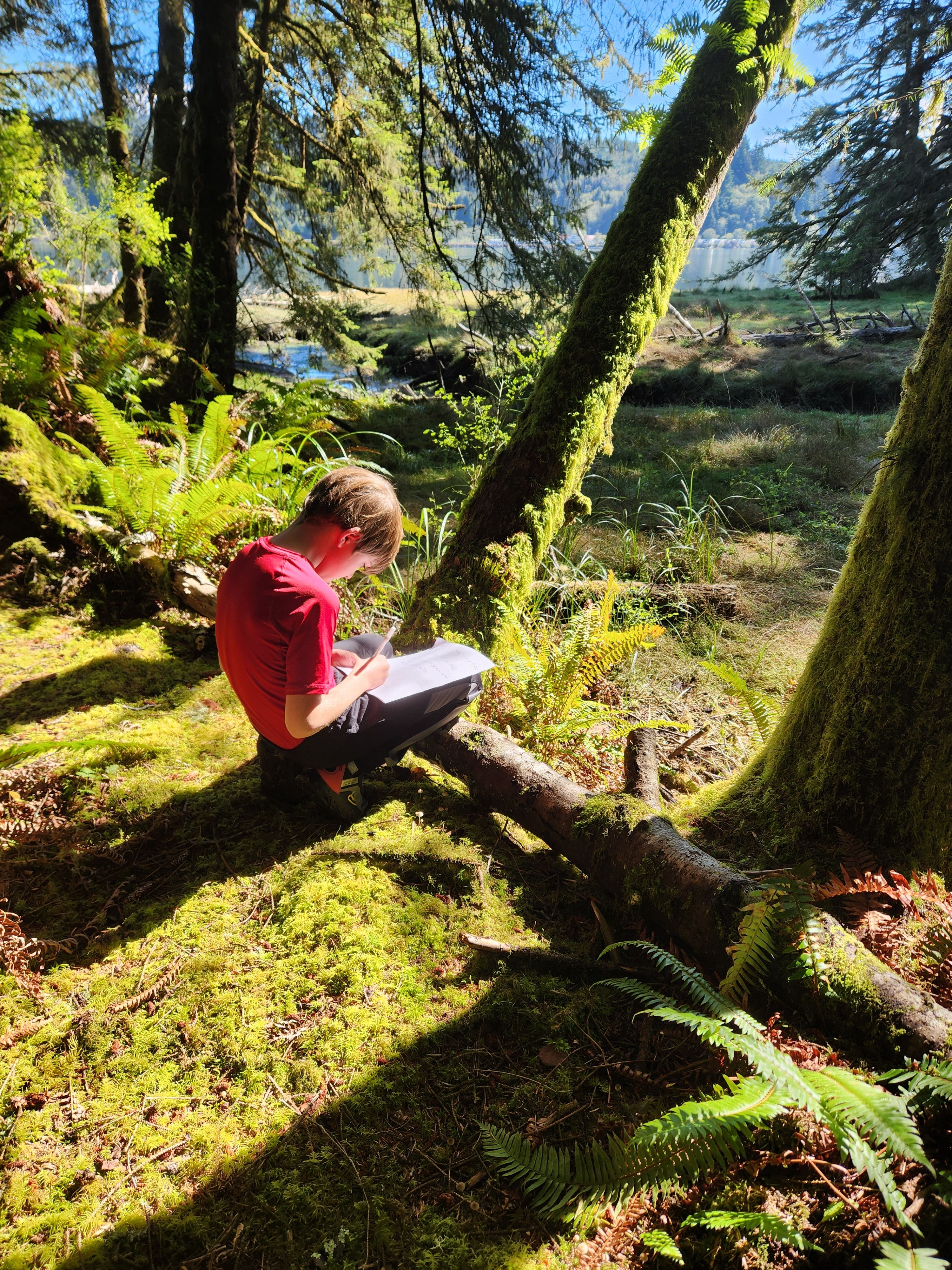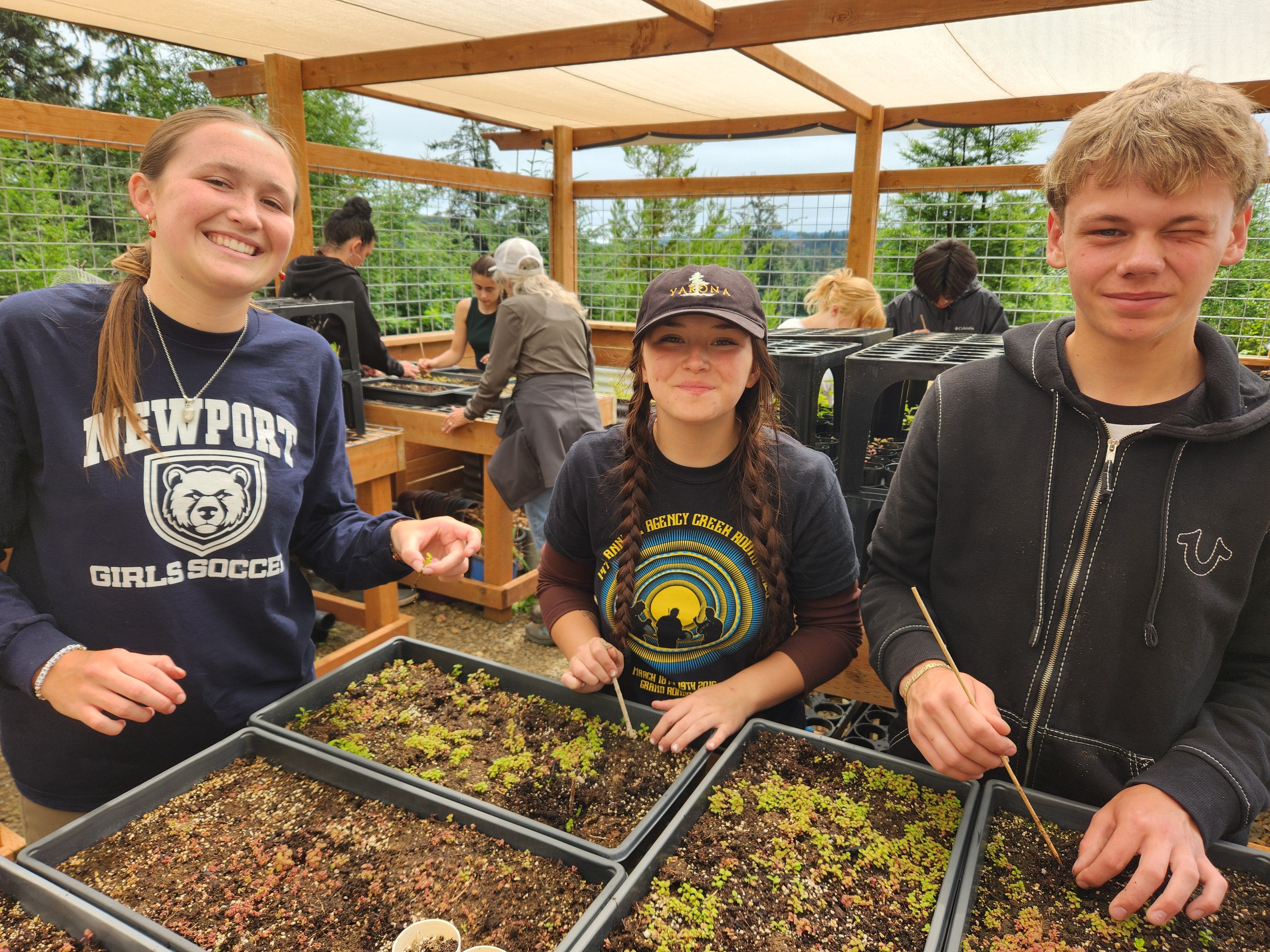Yakona Nature Preserve & Learning Center

An experimental forest brings transformation to students and the land
The Yakona Nature Preserve & Learning Center encompasses a 460-acre forested parcel shaped like a lumpy fir cone pointing towards Yaquina Bay. To the north and east is the Yaquina River; to the west, the King Slough. Travel only one to two miles from this forest as the cormorant flies and you’ll reach the Pacific Ocean or the mid-sized coastal city of Newport.
Bill and JoAnn Barton purchased the first 77-acre parcel in 2013 at the suggestion of a friend who’d noticed that the greater Newport area had no community green spaces. In the first years, they cleared trails, negotiated deeded road access, acquired more land, and built a shop. In December 2021, they hired Dr. Natalie Schaefer as the first executive director. An experienced outdoor educator, grant writer, nonprofit administrator, and executive leader, Schaefer brought all her deeply rooted skills to bear in her new role. She envisioned this peninsula as an experimental forest and educational space. Within a year, Yakona had hundreds of K-12 students visiting on free guided field trips and as part of a high school summer internship program.

The staff at Yakona are moving at a swift and careful clip. Their goals are manifold but clear: to protect, preserve, and enhance the natural ecosystems, and while doing so, create a living laboratory where students become scientists. So far this year, Yakona has hosted nearly 1,700 young people, their family members, and educators from the Lincoln County School District, Siletz Valley Charter School, and other educational programs.
“If you stand right about here,” Anna Rodgers, who leads Yakona’s educational programming, instructs, gesturing with her arm, “you can see the old property line.” To one side is a packed stand of slim evergreens; on the other side is a more spacious forest with larger trees, more luxurious ferns, and less brushy undergrowth. The first, Rodgers explains, is a recent tree plantation; the second, a mature second-growth forest. The line delineates “where they cut and where they didn’t.” She calls this the “forest mosaic”—one of the features that makes this land such a valuable educational site.
At these side-by-side stands, Rodgers has students measure the diameters of the trees, the density of the stand, and the health of the vegetation, which they enter into an app that measures carbon sequestration. She prompts them to follow their curiosity to questions: Why do the two forest types sequester carbon at different rates? What plants and animals thrive in these distinct stands? How have humans altered and used these landscapes and how might we adapt in a changing climate?
For younger kids, she leads nature journaling, offering students three prompts to respond to with words, numbers, and drawings: I notice; I wonder; this reminds me of. She’s discovered that journaling keeps her youngest students engaged and sparks their curiosity.

These programs all look to the future, but none more immediately than the eight-week paid internship program that Yakona runs for local juniors and seniors to sample a variety of natural resource careers. For four weeks, the interns work on the Preserve, tending the nursery, pulling invasive species, and doing other physical jobs. Students engage with data sets that Yakona staff have gathered over the past 3.5 years: hyper-local weekly temperature and precipitation; weekly phenology—careful documentation of the same plants as they undergo transformations through the seasons; dendrometer readings on tree expansions and contractions; and the footage from 45 wildlife web cameras that record grazing elk, stalking coyotes, and skittering chipmunks 24 hours a day. For four weeks, they work at partner organization sites to taste whether any of these careers call to them. The final week with Yakona involves building presentations on what they’ve learned and updating their resumes to reflect their experiences. The last cohort of seven included three students who went on to science programs at OSU and one who immediately applied for and received a field tech job with the local Soil and Water Conservation District.
Farther along the same trail, Rodgers stops at Yakona’s official Heritage Tree. Bounding into the sky is a 200-plus-year-old Sitka Spruce with four distinct massive pillars shooting up 158 feet (or 12 to 15 stories) from its pedestal. Yakona sits on land where the Yaqo’n people lived. Through grotesque machinations and violence that unfolded over more than a century and a half, the U.S. government took this land from the Yaqo’n, who were folded into the Confederated Tribes of Siletz Indians. Eras of brutality, tribal termination, and restoration followed.
Today, two Siletz tribal members serve on Yakona’s board, one of whom worked with the internship program this year. This Sitka Spruce likely took this form because of human manipulation by members of the Siletz tribe, who called trees like this tribal council meeting trees because they look like people gathered in a circle, conferring. They served as way markers.
Yakona staff have built relationships with Siletz tribal members that help them integrate traditional ecological knowledge into every aspect of their work. These relationships serve as way makers themselves, helping staff bridge data-centered Western science with the knowledge preserved by the original stewards of the land. Siletz Valley Charter School has an especially close relationship to the Preserve. Most students will visit this year, and Yakona staff are collaboratively building a curriculum with their teachers and administrators.
Gesturing once again towards the mosaic around us, Rodgers jokes,
When we reach our goal of old growth forest in 300 years and the forest mosaic is gone, [this place] will be less useful for education
Yakona’s forest management plans are written in five-year increments, but traditional ecological knowledge confers a more distant horizon. In 300 years, she continues, this will be an old growth forest, and what’s more useful than that?
Helpful Resources
To learn more about Yakona’s dynamic work, sign up for their newsletter and explore their website at yakonaoregon.org. If you’re an outdoor educator curious about how to teach nature journaling to students, Rodgers highly recommends this online resource and this free book from John Muir Laws.